

America does not have equal opportunity, in one chart. Americans love equality of opportunity.
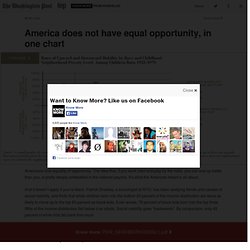
The idea that, if you work hard and play by the rules, you can end up better than you, is pretty deeply embedded in the national psyche. It’s what the American dream’s all about. And it doesn’t apply if you’re black. Patrick Sharkey, a sociologist at NYU, has been studying trends and causes of social mobility, and finds that white children born into the bottom 20 percent of the income distribution are twice as likely to move up to the top 80 percent as black kids. Even worse, 78 percent of black kids born into the top three fifths of the income distribution fall below it as adults. The effects are still worse if you look at neighborhoods with concentrated poverty.
Income Mobility: How Does Baltimore Measure Up? We like to think of the United States as an equal-opportunity kind of country, where people who work hard get rewarded, and where it’s possible for anyone to end up better off than their parents were.
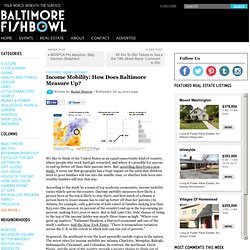
But, according data from a new study, it turns out that geography has a huge impact on the odds that children born to poor families will rise into the middle class, or whether kids born into wealthy families will stay that way. According to the study by a team of top academic economists, income mobility varies widely across the country. (Income mobility measures how likely a person born at the top is likely to stay there, and how much of a chance a person born to lesser means has to end up better off than her parents.)
Could You Survive on Fast-Food Wages? Try Our Calculator. Chief among the demands made by the hundreds of fast-food workers who walked out of their jobs this week: A raise to a "livable" wage of $15 an hour.
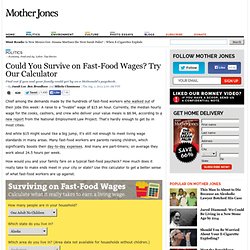
Currently, the median hourly wage for the cooks, cashiers, and crew who deliver your value meals is $8.94, according to a new report from the National Employment Law Project. That's hardly enough to get by in most cities. And while $15 might sound like a big jump, it's still not enough to meet living wage standards in many areas. Many fast-food workers are parents raising children, which significantly boosts their day-to-day expenses. And many are part-timers; on average they work about 24.5 hours per week.
How would you and your family fare on a typical fast-food paycheck? In order to make $___ a year, the typical fast-food worker has to work __ hours a week. A household like yours in ___, ___ needs to earn $__ annually to make a secure yet modest living. The average fast-food employee works less than 25 hours a week. Incomes Flat in Recovery, but Not for the 1% The most important problem facing American children today. What is the most important problem facing American children today?
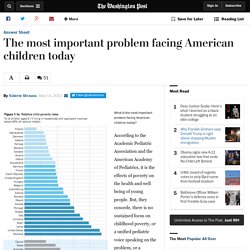
According to the Academic Pediatric Association and the American Academy of Pediatrics, it is the effects of poverty on the health and well being of young people. But, they concede, there is no sustained focus on childhood poverty, or a unified pediatric voice speaking on the problem, or a comprehensive approach to solving it. To try to remedy that, the American Pediatric Association Task Force on Childhood Poverty is beginning a long-term effort to address the problem by looking for solutions that will be effective, sustained and “protected from retrenchment,” according to this brief about the work of the panel.
Children in America are the poorest members of society. One in five children live below the federal poverty line, and almost one in two are poor or near poor, with a disproportionate burden falling on the very young, racial and ethnic minorities, Native Americans and children from immigrant families. No Rich Child Left Behind. Javier Jaén Here’s a fact that may not surprise you: the children of the rich perform better in school, on average, than children from middle-class or poor families.
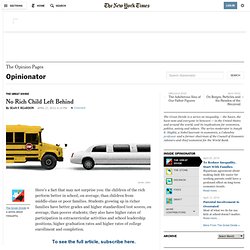
Students growing up in richer families have better grades and higher standardized test scores, on average, than poorer students; they also have higher rates of participation in extracurricular activities and school leadership positions, higher graduation rates and higher rates of college enrollment and completion. Whether you think it deeply unjust, lamentable but inevitable, or obvious and unproblematic, this is hardly news. It is true in most societies and has been true in the United States for at least as long as we have thought to ask the question and had sufficient data to verify the answer. What is news is that in the United States over the last few decades these differences in educational success between high- and lower-income students have grown substantially.
If not the usual suspects, what’s going on? Sean F. Viral Video Shows the Extent of U.S. Wealth Inequality.